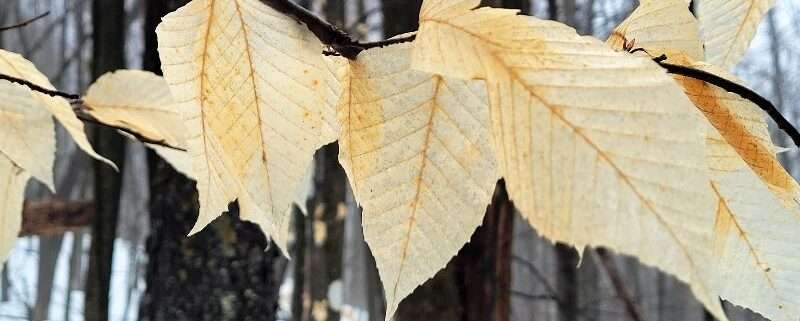Why do Beech and Oak leaves hang on through the winter?
Have you ever noticed those parchment thin leaves of the Beech tree that hang on bravely throughout the winter? What about the rich brown Oak leaves rustling like paper in the wind?
Why do these leaves persevere when all the others have fallen to the ground?
To answer this question, we need to look at both the physiology and evolution of trees. All trees shed their leaves at some time. Even though we call conifers ‘evergreens’, they lose their needle like leaves once every year. It is an individual slow process. On the opposite end of the spectrum are the deciduous trees in Quebec’s boreal forest. They light up with colour, announcing the end of their season in the fall as they let their leaves drop to the forest floor.
For a very long time, evergreens were the only trees on earth. Over time, the trees adapted to the changing climate and conditions. They developed more varieties, including the colourful, broad leaf hardwood trees. The conifers use their needles to remain photosynthetic for longer periods of time, delaying nutrient loss from dropped leaves. Deciduous trees have adapted another evolutionary strategy. They drop their leaves in order to reduce water loss and frost damage during the winter while using their broad leaves to increase their photosynthetic efficiency during the summer.
In the boreal forest you will find several varieties of evergreens like Pine, Hemlock and Spruce. Then there are also the newcomers (in an evolutionary sense) including Birch, Maple and Cherry. Between these two classes are the Beech and Oak whose leaves die but don’t fall down. Botanists call this retention of dead plant matter marcescence. It occurs when trees fail to drop their leaves because they lack the enzymes that are responsible for triggering the release of the leaf. This is the trait of the juvenile trees and is also seen on the lower branches of more mature trees.
Why do some trees have marcescent leaves? The answer is still unknown although there are some interesting theories. Here are a few of them:
– Could it be that the trees keep their leaves in order to deter deer and mice from feeding?
– Do the leaves capture the snow and in spring release moisture to feed the new spring growth?
– Is it a sign of trees adapting to dry, infertile terrain? They often are seen growing together, outcompeting other trees.
– Could it be that by dropping their leaves in the spring they are adding new compostable material to the forest floor, helping the parent tree in a landscape where every advantage is important.
– Do the leaves provide some form of frost protection to the new twigs and sprung buds?
Both the Beech and Oak are in the same family as some evergreen species including live oaks and tanoaks that don’t grow in our region. Could it be that they are simply further behind, on the long evolutionary road?
Wherever you see them, they add a touch of movement and colour to the otherwise austere black and white winter landscape. The leaves are a delight to observe as they flutter in the wind, hanging on until spring – like us.





